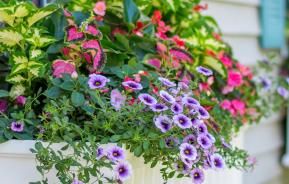Borders for birds
Rather than opting for fences for the perimeter of your garden, choose hedges as a natural alternative. Not only do they look great and add more texture to your garden, but they can absorb sound, giving you an extra private atmosphere in the garden.
Hedges and screening also provide shelter and nesting for creatures such as hedgehogs and birds. Depending on the hedging you choose, they can even act as a food supply for birds through the autumn and winter months. Ilex aquifolium (common holly) ‘J.C. van Tol’ offers so much in the garden with the glossy, evergreen foliage that is almost spineless. What’s more, this variety is self-fertile, so it doesn’t need a male holly nearby to fruit. In autumn, red berries are borne on the purple stems. The berries are popular with blackbirds, redwings, fieldfares, and song thrushes through winter.

Food for thought
There is an ever-increasing number of people in the UK following a plant-based diet, but whether you’re fully plant-based or enjoy a range of fruit and veg in your diet, growing your own produce is an all-round win.
Seeing the journey of your food grown from plant to plate is a fascinating process and even with a small space you can grow your own. Peas are a fuss-free crop, that grow vertically with ample support, so you don’t have to compromise on floor space. Strawberries can be grown in hanging baskets, watered well and fed regularly with a feed such as Performance Organics Fruit & Veg Concentrated Liquid Plant Food which is made with 100% natural and organic formula. The plant-based product is suitable for vegan growers and is also pet and child friendly.
Window boxes are another great solution for small spaces, which can be used to grow an abundance of herbs in a sunny spot. Plant up the containers with basil, oregano, rosemary, and thyme so you have a harvest of nutritious and delicious herbs at your fingertips.
Garden companions
Although, attracting wildlife into the garden can increase the likelihood of their being a race to your crops. But rather than deterring visitors from your garden, embrace it and offer other sustenance to keep them happy, rather than snacking on your crops.
Provide a meal for the pests so they don’t want to dine on your delightful harvests. For instance, cabbage white caterpillars enjoy munching on cabbages, turnips, and swedes, but planting Tropaeolum majus (nasturtiums) in the same area will encourage them to choose the bright blooms over your prized crops. For bigger and brighter blooms, feed them with Performance Organics All Purpose Concentrated Liquid Plant Food that will give you visibly healthier plants in just one week. Similarly, plant cheery looking Calendula officinalis (pot marigold) to attract slugs to stop them snacking on leaves in the veg plot.

Making your own compost
Produce your own nutrient rich organic compost to add as a soil conditioner to make the most out of waste from the kitchen and garden.
For the right balance, incorporate ‘green’ materials like vegetable peelings, tea bags, and grass cuttings that are high in nitrogen. ‘Brown’ materials are those that have high carbon content such as cardboard and straw. Adding half of each is the general rule, but it can be adjusted by adding more brown materials if the mix is too wet. When the compost is dark and crumbly in appearance with an earth fragrance, it’s ready to be added to your beds, borders, fruit, and veg to improve the soil and provide a boost of nutrients.
Make your garden a welcoming space for wildlife with food, drink and habitats for them. Choose practices and products that embrace and protect garden visitors, and make the most of the resources at your fingertips to grow your own food and make compost from garden waste.








